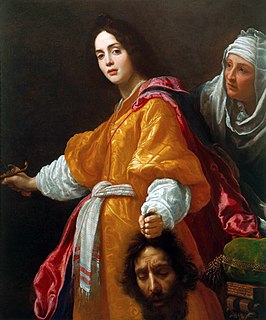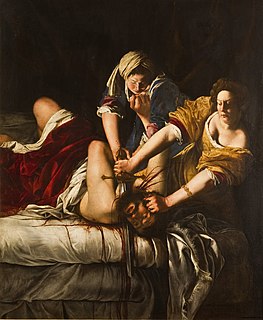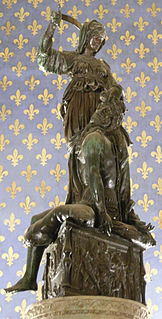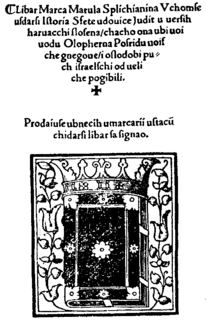
The Book of Judith is a deuterocanonical book, included in the Septuagint and the Catholic and Eastern Orthodox Christian Old Testament of the Bible, but excluded from the Hebrew canon and assigned by Protestants to the Apocrypha. The book contains numerous historical anachronisms, which is why some scholars now accept it as non-historical; it has been considered a parable, a theological novel or perhaps the first historical novel.

Cristofano Allori was an Italian portrait painter of the late Florentine Mannerist school. Allori was born at Florence and received his first lessons in painting from his father, Alessandro Allori, but becoming dissatisfied with the hard anatomical drawing and cold coloring of the latter, he entered the studio of Gregorio Pagani, who was one of the leaders of the late Florentine school, which sought to unite the rich coloring of the Venetians with the Florentine attention to drawing. Allori also appears to have worked under Cigoli.

In the deuterocanonical Book of Judith, Holofernes is an Assyrian invading general dispatched by Nebuchadnezzar to take vengeance on the nations of the West who withheld assistance to his reign. Holofernes occupied all the countries along the sea coast and destroyed all their gods, so that they would worship Nebuchadnezzar alone. Holofernes was warned against attacking the Jewish people by Achior, the leader of the children of Ammon, which angered him and his followers; they rebuked him, insisting that there was no god other than Nebuchadnezzar.
The Old English poem Judith describes the beheading of Assyrian general Holofernes by Israelite Judith of Bethulia. It is found in the same manuscript as the heroic poem Beowulf, the Nowell Codex, dated ca. 975–1025. The Old English poem is one of many retellings of the Holofernes–Judith tale as it was found in the Book of Judith, still present in the Catholic and Orthodox Christian Bibles. Most notably, Ælfric of Eynsham, late 10th-century Anglo-Saxon abbot and writer, composed a homily of the tale.

Judith Holfelder-Roy, known by her stage name Judith Holofernes, is a German singer, guitarist, songwriter and author. She is best recognized as the lead singer of Wir sind Helden, a German pop rock band that came to fame in Germany following the release of the song "Guten Tag" in 2002. The band received critical acclaim owing in part to Holofernes' lyrics, which are characterized by their playful use of words and their often sociocritical nature.

Judith Beheading Holofernes is a painting of the biblical episode by Caravaggio, painted in c. 1598–1599. The widow Judith first charms the Syrian general Holofernes, then decapitates him in his tent. The painting was rediscovered in 1950 and is part of the collection of the Galleria Nazionale d'Arte Antica in Rome.

Judith and Holofernes (1457–1464) is a bronze sculpture created by the Italian Renaissance sculptor Donatello at the end of his career. It can be seen in the Hall of Lilies, in the Palazzo Vecchio, Florence, Italy. A copy stands in one of the sculpture's original positions on the Piazza della Signoria, in front of the Palazzo Vecchio.

Judith, is an opera in five acts, composed by Alexander Serov during 1861–1863. Derived from renditions of the story of Judith from the Old Testament Apocrypha, the Russian libretto, though credited to the composer, has a complicated history. The premiere took place in 1863 in Saint Petersburg. This stage debut, supplemented with his next opera Rogneda, made Serov the most important Russian opera composer of the 1860s.

Judith of Bethulia (1914) is an American film starring Blanche Sweet and Henry B. Walthall, and produced and directed by D. W. Griffith, based on the play of the same name by Thomas Bailey Aldrich. The film was the first feature-length film made by pioneering film company Biograph, although the second that Biograph released.

Judith at the Banquet of Holofernes is a painting by the Dutch master Rembrandt. It is housed in the Museo del Prado of Madrid, Spain. It is signed "REMBRANDT F: 1634".

Judita ("Judith") is one of the most important Croatian literary works, an epic poem written by the "father of Croatian literature" Marko Marulić in 1501.

The account of the beheading of Holofernes by Judith is given in the deuterocanonical Book of Judith, and is the subject of many paintings and sculptures from the Renaissance and Baroque periods. In the story, Judith, a beautiful widow, is able to enter the tent of Holofernes because of his desire for her. Holofernes was an Assyrian general who was about to destroy Judith's home, the city of Bethulia. Overcome with drink, he passes out and is decapitated by Judith; his head is taken away in a basket.

Judith Slaying Holofernes is a painting by the Italian early Baroque artist Artemisia Gentileschi completed in 1610 and now in the Uffizi Gallery, Florence, Italy. The work shows the scene of Judith beheading Holofernes, common in art since the early Renaissance, as part of the group of subjects art critics have called the "Power of Women", which show women triumphing over powerful men. The subject takes an episode from the apocryphal Book of Judith in the Old Testament, which recounts the assassination of the Assyrian general Holofernes by the Israelite heroine Judith. The painting shows the moment when Judith, helped by her maidservant, beheads the general after he has fallen asleep drunk.

Judith and Holofernes is the name given to one of the 14 Black Paintings painted by Francisco de Goya between 1819 and 1823. By this time, Goya was in his mid 70s and deeply disillusioned. In mental and physical despair, he painted the private works on the interior walls of his home—applying oils directly on plaster—known as the Quinta del Sordo, which he had purchased in 1819. Judith and Holofernes was likely painted on the first floor, beside Saturn Devouring His Son. The picture is a personal reinterpretation of the narrative of the Book of Judith, in which the protagonist saves Israel from the assault of the general Holofernes by seducing and beheading him. Judith is the only historical figure who can be identified with certainty among the Black Paintings.

Judith and Holofernes is a painting by the Italian Renaissance artist Andrea Mantegna, painted about 1495, depicting the common subject in art of Judith beheading Holofernes.

Judith and the Head of Holofernes is an oil painting by Gustav Klimt created in 1901. It depicts the biblical character of Judith holding the severed head of Holofernes.
Judith and Holofernes may refer to:

Head of a Tyrant or Judith and Holofernes is a 1959 Italian-French historical film directed by Fernando Cerchio and starring Massimo Girotti, Isabelle Corey and Renato Baldini.

Judith and Her Maidservant is one of three paintings by the Italian baroque artist Artemisia Gentileschi that depicts the biblical story of Judith and Holofernes. This particular work, executed in the 1620s, now hangs in the Detroit Institute of Arts. The narrative is taken from the deuterocanonical Book of Judith, in which Judith seduces and then murders the general Holofernes. This precise moment illustrates the maidservant wrapping the severed head in a bag, moments after the murder, while Judith keeps watch. The other two paintings of this subject were completed earlier in her career, and are now shown in the Museo di Capodimonte in Naples and the Musee de la Castre, Cannes.

Judith Slaying Holofernes is a 1620–1621 painting by Artemisia Gentileschi, now in the Uffizi Gallery in Florence. Like her earlier version of the work, Judith is thought to be a self-portrait. Holofernes is thought to be a portrait of Agostino Tassi, the mentor her father hired to teach Artemesia because women were not allowed to attend the art academy. Tassi raped her while she was under his tutelage.















